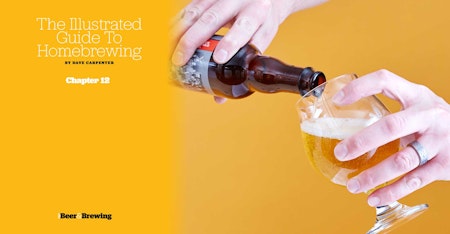Subscriber Exclusive
Recipe: Burning Beard In Praise of Bacchus
Here is a homebrew-scale recipe for Burning Beard’s spontaneously fermented lambic-style beer. Including a turbid mash schedule and long boil, it’s inspired by the traditional methods followed by Belgian lambic brewers.
All Access Subscribers can download the Beersmith and BeerXML version of this recipe.
Subscribe today.
“Honestly, our only real contribution to this style is believing in it,” says Jeff Wiederkehr, Burning Beard’s cofounder and head brewer. “Believing in the magic of the process and being willing to let go.”
ALL-GRAIN
Batch size: 5 gallons (19 liters)
Brewhouse efficiency: 77%
OG: 1.052
FG: 1.000
IBUs: 8
ABV: 6.25%
“Honestly, our only real contribution to this style is believing in it,” says Jeff Wiederkehr, Burning Beard’s cofounder and head brewer. “Believing in the magic of the process and being willing to let go.”
ALL-GRAIN
Batch size: 5 gallons (19 liters)
Brewhouse efficiency: 77%
OG: 1.052
FG: 1.000
IBUs: 8
ABV: 6.25%
[PAYWALL]
MALT/GRAIN BILL
4.75 lb (2.7 kg) Belgian pilsner
3.25 lb (1.8 kg) Unmalted wheat
1 lb rice hulls
YEAST
Let go and have a homebrew.
HOPS SCHEDULE
Use aged noble hops [approx. 0.4% AA]
We are using hops aged four to six years.
With the hops you have on hand, use your favorite ibu/hop age calculator to approximate 5 to 8 ibu following this schedule:
1 oz at 60 minutes
2 oz at 30 minutes
5 oz at flame-out
DIRECTIONS
Mill grains and follow a turbid mash schedule (For more information, see “Turbid Mashing,” beerandbrewing.com)[https://beerandbrewing.com/turbid-mashing/], aiming for these steps:
- Mash in thick (about 75% of your prefered water to mash ratio) at 113°F (45°C) and hold 15 minutes;
- Boil the remaining portion of your water (the 25% you left out), stir in to raise the temperature to 130°F (54°C), hold 10 minutes;
- Pull off about one to two quarts of the mash to boil (to be honest, more often than not, I need closer to two quarts to hit my temp; stir in to raise to 145°F (63°C) and hold 30 minutes (don’t be alarmed if you are a little over temp);
- Pull off approximately 25% of the mash liquid to boil and stir in to raise to 160°F (71°C) and hold 15 minutes (don’t be alarmed if you are a little under temp);
- Vorlauf, lauter and sparge at ~ 188°F (87°C) as necessary to get about 7.6 gallons (29 liters) of wort—or more, depending on your evaporation rate.
Yes, the sparge is hot, we are actually trying to extract tannins.
Boil for 4 hours, adding aged hops according to the above schedule.
After the boil, transfer to a makeshift coolship, if you don’t have a coolship, a 5-gallon mash tun has a pretty good surface area to volume ratio, use it. Set it on a patio, on your roof, in a forest, or in your kitchen to cool overnight (see “Spontaneity: Prospecting for Bugs,” beerandbrewing.com)[https://beerandbrewing.com/spontaneity-prospecting-for-bugs/].
Note: If you happen to be in the ladies garment section of your local market, grab some pantyhose. I pull that over the mash tun to keep the bugs out while it cools. Disregard my previous statement about contributions: I have belief and pantyhose!
Transfer to a small oak barrel or, optionally, a fermentor with oak cubes, and age for 12 months or more.
If your barrel is new, I recommend rinsing it several times to reduce some of the oak character. The new barrel can overwhelm a delicate beer.
BREWER’S NOTES
We don’t pitch any yeast, we just turn on the positive pressure fan to pull in the night air, and then we close the door to the shed. As a spontaneously fermented beer, the idea is not to pitch any extraneous yeast or bacteria. However, if you want something somewhat more predictable, some yeast labs sell blends of lambic bugs, such as Wyeast 3278; alternatively, 3763 is fun, or you could even pitch a growler full of fancy dregs. Another fun way to inoculate is to soak your oak cubes in a sort of “wild starter.” You don’t pitch the yeast per se, but you do pitch semi-predictable cubes.
Either way, if you are not sure that you want to go 100 percent spontaneous and leave all of your hard work up to the brewing gods, and you plan to pitch yeast of some sort, I recommend that before you do, pull off some of the spontaneous stuff and bottle it, just to test it out. And, who knows, if you like what you get, you might want to go all-spontaneous next time.








